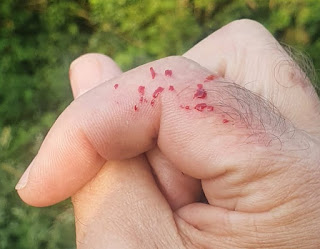I've posted already about our concerns over the lack of young birds in our recent moderate catch totals. Over the last week things have changed as both the catch size, and the proportion of juvenile birds has begun to increase. It really does look like the very cold northerly winds during April have had a marked effect on the timing of breeding. It will be interesting to read the BTO report on breeding which will come out next year with an analysis across the whole of the UK--and see where our little patch fits with the rest of the country.
The team set out early again yesterday and although the sun rose with no cloud, by about 8am, a cover of cloud brought a welcome cooling and shade for the nets. The total catch was 62 new birds--improving-- of which 47 were warblers--improving and of the total catch, 90% were juveniles--improving again!
The ratio of species was about as normal, but Reed Warblers in particular are now fledging and 19 new Reed Warblers in the catch reflected this. However, within the catch of Reed Warblers there was, as always, a number of old favourites!! One in particular- turned out to be a bird we originally ringed at the reserve as a juvenile bird in 2014. Just considering this for a moment... it means that this little bird weighing around 15 grams has flown to the south of Africa and back 7 times. Setting aside flying time at both ends of these migration flights, we reckon it must have clocked up the best part of 150,000 miles on migration trips alone!! Stunning!!.
A couple of pictures help tell some more stories from yesterday:-
The site has been a hot spot for the very localised Tree Sparrow population--but in recent years the numbers have been very variable and sometimes absent. So it was great to see that at least one of the nestboxes has been used by this species and a very healthy brood of 3 youngsters was present and ready for ringing. Here is one of them showing the wing and tail feathers just starting to protrude from their growing sheath or 'pin'.



No comments:
Post a Comment